Explore The Magnificent Agung Jagatnatha Temple Of Bali In 2025
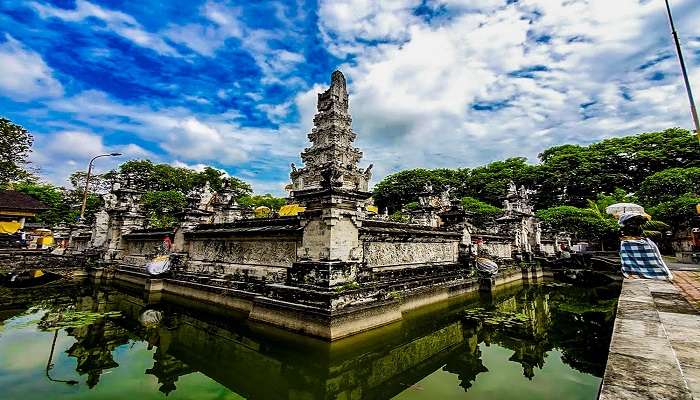
In Bali’s core, the serene Agung Jagatnatha Temple stands. It welcomes folks to dive into the local deep-seated Hindu culture. This magnificent temple, complex carvings, settled in rich tropical scenery, connects guests with sacred forces. The temple, honouring the ultimate god Sang Hyang Widhi Wasa, is famous for its grand design. It has tall meru shrines and decorative doors. The se represents a link to the spiritual and celestial spaces. This temple is a central place in Bali for worshipping, festive events, and holding onto old island customs.
Places To Visit Near Agung Jagatnatha Temple
If you’re visiting the Agung Jagatnatha Temple, you should also explore other tourist attractions nearby. Check out the places listed below before making your itinerary.
1. Pura Maduwe Karang
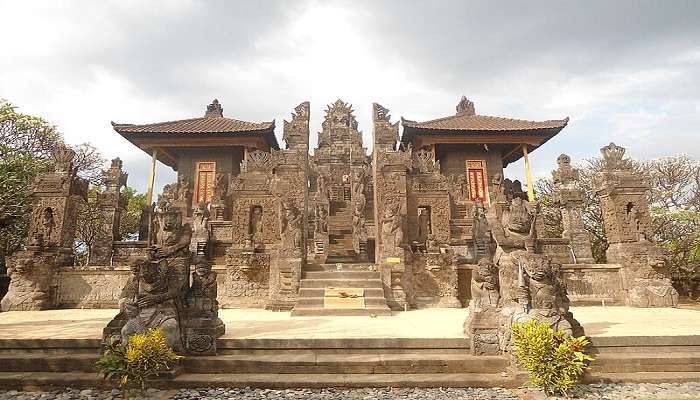
In the scenic Kubutambahan area, about 12 kilometres east of Singaraja in north Bali, you can find the amazing Pura Maduwe Karang. This Hindu temple is large and beautifully adorned. It’s well-known due to its detailed stone artwork, which includes a famous bicycle carving and a unique North Balinese architectural design. The temple honours the god Batara Meduwe Karang.
People believe this god helps the island’s farms to be productive. This makes the Pura Maduwe Karang one of the big-league Hindu temples in Bali. The temple grounds hold a central shrine, more small shrines, and a collection of skillfully chiselled stone doorways and buildings. Anyone visiting can marvel at the extensive carvings. They show moments from the Ramayana story and the notable bicycle carving that symbolises the temple.
Entry Fees: IDR 15,000 for adults and IDR 7,500 for children
Timings: 8:00 AM to 5:00 PM
Must Read: Bali Temples
2. Pura Taman Saraswati
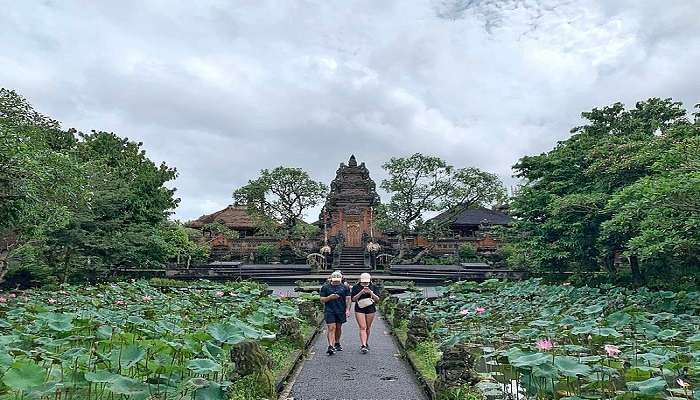
You’ll find Pura Taman Saraswati in Ubud, Bali’s heart. It’s a special water temple that people all over the world love to visit. It stands out for its beautiful design, peaceful lotus ponds, and calming vibe. Dedicated to Saraswati, a Hindu goddess known for knowledge, arts, and music, this place is a real sensory treat. A specially carved stone gateway marks the temple’s main entrance, welcoming visitors into a magical place.
Wonderful stone bridges cross over the serene lotus ponds, filled up with stunning flowers and paired with green scenes ry. As you roam the temple area, you’ll grow to love the attention to detail observed in Balinese design. With its detailed carvings, tall split gates, and refined pavilions, there’s much to admire. The primary shrine, boasting a unique multi-layered roof, shows off the superb skills of the Balinese creators who built this appealing place.
Entry Fees: IDR 15,000 for adults and IDR 7,500 for children
Timings: 8:00 AM to 6:00 PM
3. Pura Dalem Ubud

Ubud, Bali, bustles with life. Amongst it, stands Pura Dalem Ubud, an influential Hindu temple. This spiritual location is loved for its detailed rock engravings, elaborate patterns, and its function as a social and religious centre. Shiva, the transformation and end Hindu God, has been worshipped here since its creation in the 14th century. The temple space has various gates, spiritual places, and canopies decorated with the work of Balinese masters.
Here, visitors can appreciate the complex designs telling Hindu tales and the beautiful sculptures around the temple area. But, what’s truly unique about Pura Dalem Ubud? It’s surrounded by the lively roads and colourful bazaars of Ubud. This prime spot makes the temple a community hotspot, hosting frequent rituals, holidays, and cultural events that attract both locals and tourists.
Entry Fees: IDR 15,000 for adults and IDR 7,500 for children
Timings: 8:00 AM to 5:00 PM
Suggested Read: Temples In Sanur Bali
4. Ubud Royal Palace
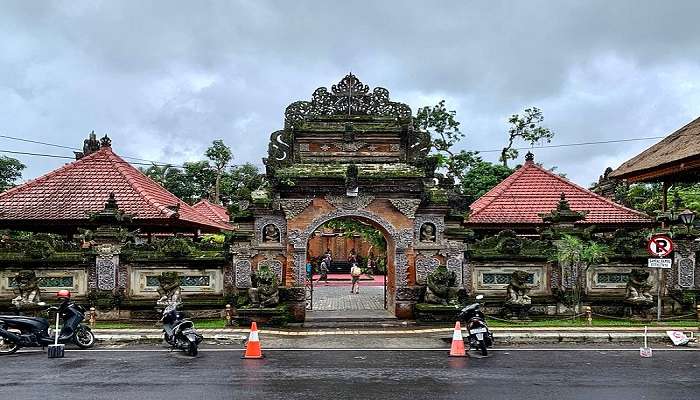
In the heart of Ubud, you’ll find the Ubud Royal Palace. It’s a symbol of Bali’s deep history and culture. This mesmerising place invites guests to see island royalty’s unique side and the fantastic architecture and timeless customs that have moulded this area for a very long time. The Ubud Royal Palace used to be home to Ubud’s royal family, the past rulers of this region. This vast palace features wonderfully preserved buildings, like fancy pavilions, carvings on the gateways, and peaceful courtyards.
People can wander around, observing the complex stone artistry, the vivid murals, and the outstanding architecture typical to Bali that decorates the palace. Not just beautiful buildings, the Ubud Royal Palace is also a centre for the arts. Here, you can see typical Balinese music and dance performances, which offer insights into the island’s artistic customs. The palace not only hosts regular functions and festivals, but it also lets people experience Ubud’s lively and colourful culture.
Entry Fees: IDR 80,000 for adults and IDR 40,000 for children
Timings: 8:00 AM to 5:00 PM
5. Sakenan Temple
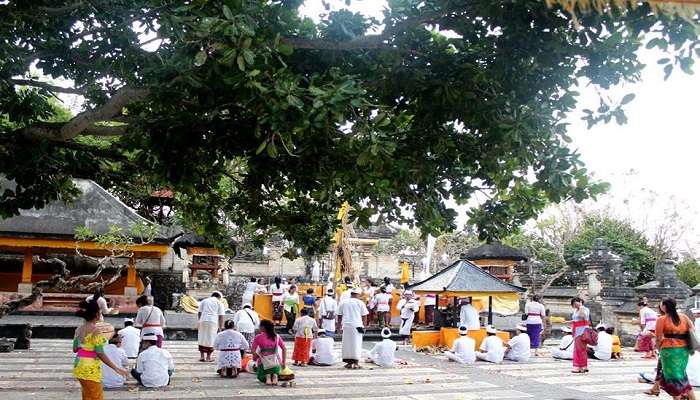
On the tiny island of Serangan, just under Denpasar, Bali sits Pura Dalem Sakenan, or Sakenan Temple. It’s a fascinating Hindu site that’s steeped in the island’s spiritual and cultural history. It’s dedicated to the god known as Rambut Sedhana. People believe Sakenan Temple started in the 1500s and since then, it has represented wealth and happiness. The temple’s architecture is interesting; it mixes normal Balinese features with parts from Hindu and Buddhist styles.
When you visit, you can see detailed gates, beautifully ornamented holy places, and tall roofs with many tiers that make the temple’s design different. Sakenan Temple means a lot to the people who live nearby. It’s the main place for the 210-day-long Piodalan festival. During this big event, the faithful used to walk to the island, showing the temple’s old and deep connection to Bali’s spiritual past.
Entry Fees: No Entry Fee
Timings: 8:00 AM to 5:00 PM
Suggested Read: Denpasar Temples
6. Campuhan Ridge Walk
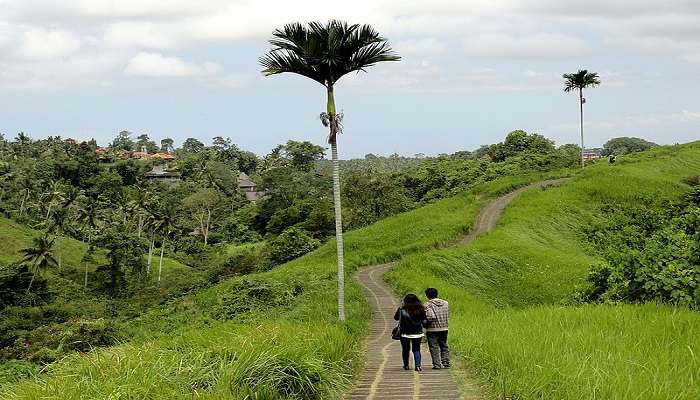
Difficult to miss in the middle of Ubud, Bali, walkers find rest and quiet along Campuhan Ridge Walk. This less than 6-mile trail twists and turns in the vibrant green fauna, offering a wide and beautiful view of the hills around. Explorers stepping onto the Campuhan Ridge Walk immediately get wrapped in Ubud region’s wonderful outdoor beauty. The path leads them through a dense green forest with local wildlife, from monkeys and birds to even butterflies.
As the path gradually goes upward, the Campuhan River Valley opens to the view along with the undulating hills defining the Ubud landscape. At different hours of the day, Campuhan Ridge Walk shows different faces. Early morning walks might get foggy, creating a mysterious feel, while afternoons give clear sight of the lush green landscape. The golden light washing over the trail at dusk gives {a truly magical touch to the whole experience.
Entry Fees: No Entry Fee
Timings: 6:00 AM to 6:00 PM
Further Read: Things To Do In Bali
Join a memorable trip to the Agung Jagatnatha Temple. See traditions that date back hundreds of years. Wander in holy yards, watch prayer practices and feel the spiritual energy of this divine place. Dive into the deep respect and calm spirit that this unique Balinese landmark produces. Arrange your visit to the Agung Jagatnatha Temple now and discover the mystic beauty of this respected Balinese holy place. Organize your stay, book your trip to Bali, and prepare for an inspirational trip that will give you a stronger insight into Bali’s profound cultural and spiritual customs.
For our editorial codes of conduct and copyright disclaimer, please click here.
Cover Image Source: Facebook
Frequently Asked Questions About Agung Jagatnatha Temple
What is the Agung Jagatnatha Temple?
It's an awesome temple in Denpasar, Bali in Indonesia. Known as Pura Agung Jagatnatha, it's rich in history and culture. This Hindu temple dates back to the 14th century. It's a place of great respect for the Hindu community, being de voted to deities such as Shiva, Brahma, and Vishnu.
What is the Agung Jagatnatha Temple's history?
The Agung Jagatnatha Temple's history is as old as the 14th century! The Majapahit Empire was in power then, with a grand legacy of the Hindu-Buddhist culture across the Indone sian islands. Throughout the years, the temple has had various makeovers, reaffirming its spiritual significance to Balinese Hindus.
Why is the Agung Jagatnatha Hindu Temple significant?
This temple shines for its appealing design and dynamic etchings. It boasts a variety of shrines and pavilions. Its fame comes from its meru - a multi-levelled canopy. The lovely gateways, murals, and stone drawings depict Hindu tales.
What are the Agung Jagatnatha Temple timings?
The Agung Jagatnatha Temple timings stay open for guests from 8:00 AM to 6:00 PM every day. Hours could change for special occasions or religious ceremonies, so it's smart to double-check their website or ask locals.
What is the entry fee to enter the Agung Jagatnatha Temple?
There's none! Entrance to the Agung Jagatnatha Temple is free. However, remember it's a holy place. Visitors should wear appropriate attire. Long pants or skirts and tops that cover the shoulders are suggested.
People Also Read:
Derthu Mata Temple Dalai Lama Temple Champavati Temple

Unveil the hidden treasures of the globe and turn every travel dream into reality. As a Content Writer, I am passionate enough to craft stories from ancient wonders to modern marvels. My words paint the picture-perfect itinerary for unforgettable experiences. Let my words be your trusted guide to immerse in the diverse culture and discover the beauty of the unknown.











